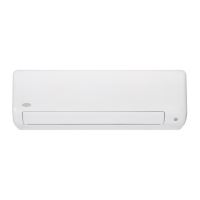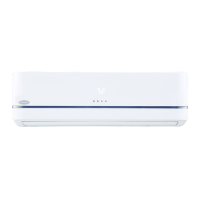Do you have a question about the Carrier 40MAHBQ06XA and is the answer not in the manual?
Details on the compatibility of indoor units with outdoor units.
Covers methods like deep vacuum and triple evacuation for system charging.
Important checks for refrigerant lines to prevent damage or leaks.
Covers protections related to fan speed control and inverter module.
Details protections for indoor fan, zero crossing, and sensor malfunctions.
Details on FAN mode, COOLING mode fan rules, and evaporator temperature protection.
Heating mode fan rules, anti-cold air function, and defrosting mode operation.
Operation of AUTO mode and features/protections in DRYING mode.
Covers evaporator anti-freezing, outdoor fan behavior, and forced operation modes.
Discusses auto-restart, leak detection, and louver position memory functions.
Features for quiet operation and checking unit information via remote controller.
Important safety warnings, especially regarding capacitor discharge.
List and description of error codes displayed by the indoor unit.
Troubleshooting for EEPROM parameter errors, including causes and conditions.
Guides through troubleshooting communication errors between indoor and outdoor units.
Instructions for testing DC voltage between unit terminals using a multimeter.
Procedure for testing reactor resistance to identify malfunctions.
Troubleshooting steps for zero crossing detection errors in the PCB.
Steps to diagnose and resolve indoor fan speed control errors.
Troubleshooting for indoor and outdoor DC fan motors and indoor AC fan motors.
Steps to diagnose open or short circuits in temperature sensors.
Troubleshooting for refrigerant leakage detection, including sensor and system checks.
Troubleshooting steps for overload current protection issues.
Diagnosing IPM malfunction or IGBT over-current protection errors.
Visual guide for measuring PCB voltage points P and U.
Visual guide for measuring PCB voltage points P and V.
Visual guide for measuring PCB voltage points P and W.
Visual guide for measuring PCB voltage points N and U.
Visual guide for measuring PCB voltage points N and V.
Visual guide for measuring PCB voltage points N and W.
Troubleshooting for over voltage or low voltage protection issues.
Steps to diagnose and resolve compressor high temperature protection errors.
Diagnosing abnormal inverter compressor drive signals and performance.
Procedure for checking the resistance of various temperature sensors.
Table of resistance values for temperature sensors T1, T2, T3, and T4.
Table of resistance values for the T5 temperature sensor.
Table for temperature conversions (Fahrenheit to Celsius).
Step-by-step guide to removing and disassembling the front panel of the indoor unit.
Instructions for safely disassembling electrical components, requiring anti-static gloves.
Procedures for removing the evaporator, including front panel, electrical parts, and fan.
Steps to remove the fan motor and fan assembly from the indoor unit.
Details on the compatibility of indoor units with outdoor units.
Covers methods like deep vacuum and triple evacuation for system charging.
Important checks for refrigerant lines to prevent damage or leaks.
Covers protections related to fan speed control and inverter module.
Details protections for indoor fan, zero crossing, and sensor malfunctions.
Details on FAN mode, COOLING mode fan rules, and evaporator temperature protection.
Heating mode fan rules, anti-cold air function, and defrosting mode operation.
Operation of AUTO mode and features/protections in DRYING mode.
Covers evaporator anti-freezing, outdoor fan behavior, and forced operation modes.
Discusses auto-restart, leak detection, and louver position memory functions.
Features for quiet operation and checking unit information via remote controller.
Important safety warnings, especially regarding capacitor discharge.
List and description of error codes displayed by the indoor unit.
Troubleshooting for EEPROM parameter errors, including causes and conditions.
Guides through troubleshooting communication errors between indoor and outdoor units.
Instructions for testing DC voltage between unit terminals using a multimeter.
Procedure for testing reactor resistance to identify malfunctions.
Troubleshooting steps for zero crossing detection errors in the PCB.
Steps to diagnose and resolve indoor fan speed control errors.
Troubleshooting for indoor and outdoor DC fan motors and indoor AC fan motors.
Steps to diagnose open or short circuits in temperature sensors.
Troubleshooting for refrigerant leakage detection, including sensor and system checks.
Troubleshooting steps for overload current protection issues.
Diagnosing IPM malfunction or IGBT over-current protection errors.
Visual guide for measuring PCB voltage points P and U.
Visual guide for measuring PCB voltage points P and V.
Visual guide for measuring PCB voltage points P and W.
Visual guide for measuring PCB voltage points N and U.
Visual guide for measuring PCB voltage points N and V.
Visual guide for measuring PCB voltage points N and W.
Troubleshooting for over voltage or low voltage protection issues.
Steps to diagnose and resolve compressor high temperature protection errors.
Diagnosing abnormal inverter compressor drive signals and performance.
Procedure for checking the resistance of various temperature sensors.
Table of resistance values for temperature sensors T1, T2, T3, and T4.
Table of resistance values for the T5 temperature sensor.
Table for temperature conversions (Fahrenheit to Celsius).
Step-by-step guide to removing and disassembling the front panel of the indoor unit.
Instructions for safely disassembling electrical components, requiring anti-static gloves.
Procedures for removing the evaporator, including front panel, electrical parts, and fan.
Steps to remove the fan motor and fan assembly from the indoor unit.
| Type | Ductless Mini Split |
|---|---|
| Cooling Capacity | 6, 000 BTU/h |
| Refrigerant | R-410A |
| Voltage (V) | 115 |
| Weight (Indoor Unit) | 17.6 lbs |
| Height (in) | 11.22 |












